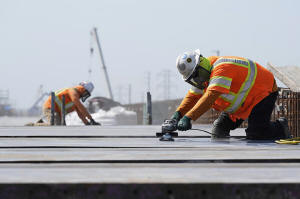Trump administration pulls $4B in federal funding for California's
bullet train project
[July 17, 2025] By
SOPHIE AUSTIN
SACRAMENTO, Calif. (AP) — The Trump administration revoked federal
funding for California's high-speed rail project on Wednesday,
intensifying uncertainty about how the state will make good on its
long-delayed promise of building a bullet train to shuttle riders
between San Francisco and Los Angeles.
The U.S. Transportation Department announced it was pulling back $4
billion in funding for the project, weeks after signaling it would do
so. Overall, a little less than a quarter of the project's funding has
come from the federal government. The rest has come from the state,
mainly through a voter-approved bond and money from its cap-and-trade
program.
President Donald Trump and Transportation Secretary Sean Duffy both have
slammed the project as a “train to nowhere."
“The Railroad we were promised still does not exist, and never will,"
Trump wrote on Truth Social. "This project was Severely Overpriced,
Overregulated, and NEVER DELIVERED.”
The loss marks the latest blow to California by the Trump
administration, which has blocked a first-in-the-nation rule to phase
out the sale of new gas-powered cars, launched investigations into
university admission policies and threatened to pull funding over
transgender girls being allowed to compete in girls sports.

It also comes as rail project leaders are seeking private investment to
help pay for its estimated price tag of more than $100 billion.
Voters first approved the project in 2008 and it was supposed to be
operating this decade. But cost estimates have consistently grown and
its timeline pushed back.
State officials are now focused on building a 119-mile (192-kilometer)
stretch connecting the Central Valley cities of Bakersfield and Merced
that is set to be operating by 2033. The California High Speed Rail
Authority is slated to release a report this summer to state lawmakers
with an updated funding plan and timeline for the project.
Authority officials wrote in a letter earlier this month that the Trump
administration made up its mind about revoking funding before thoroughly
reviewing the project. They noted that more than 50 structures have
already been built, including underpasses, viaducts and bridges to
separate the rail line from roadways for safety.
“Canceling these grants without cause isn’t just wrong — it’s illegal,”
authority CEO Ian Choudri said in a statement Wednesday. “These are
legally binding agreements, and the Authority has met every obligation,
as confirmed by repeated federal reviews, as recently as February 2025."
[to top of second column] |

Ironworkers with the California High-Speed Rail Authority work on
the Hanford Viaduct, Tuesday, April 15, 2025, in Kings County,
Calif. (AP Photo/Godofredo A. Vásquez, File)

The authority has asked potential private investors to express their
interest by the end of the month.
Democratic Gov. Gavin Newsom said the state will keep “all options on
the table” to fight the revocation of federal funds.
“Trump wants to hand China the future and abandon the Central Valley. We
won’t let him," he said in a statement.
The state has “no viable plan” to complete even the Central Valley
segment, said Drew Feeley, acting administrator of the transportation
department's Federal Railroad Administration, in a report released last
month. He called the project a “story of broken promises” and a waste of
taxpayer dollars.
California Democrats also have criticized project spending. Democratic
Assemblymember Rebecca Bauer-Kahan said at a budget hearing earlier this
year that her constituents “overwhelmingly believe” high-speed rail
spending “has been irresponsible.”
Newsom plans to extend the state's cap-and-trade program, a key funding
source for the project which is set to expire at the end of 2030,
through 2045.
The program sets a declining limit on the total amount of greenhouse gas
emissions large emitters can release. Those polluters can buy allowances
from the state needed to pollute, and about 45% of that money goes into
what's known as the Greenhouse Gas Reduction Fund, according to the
Independent Emissions Market Advisory Committee, a group of experts that
reviews the program.
The fund helps pay for climate and transportation projects, including
high-speed rail.
The bullet train project receives 25% of the money from the fund, which
ends up being a little less or a little more than $1 billion annually,
depending on the year. Newsom in May proposed guaranteeing $1 billion a
year for the project from the fund, but lawmakers have not agreed to
that.
All contents © copyright 2025 Associated Press. All rights reserved
 |